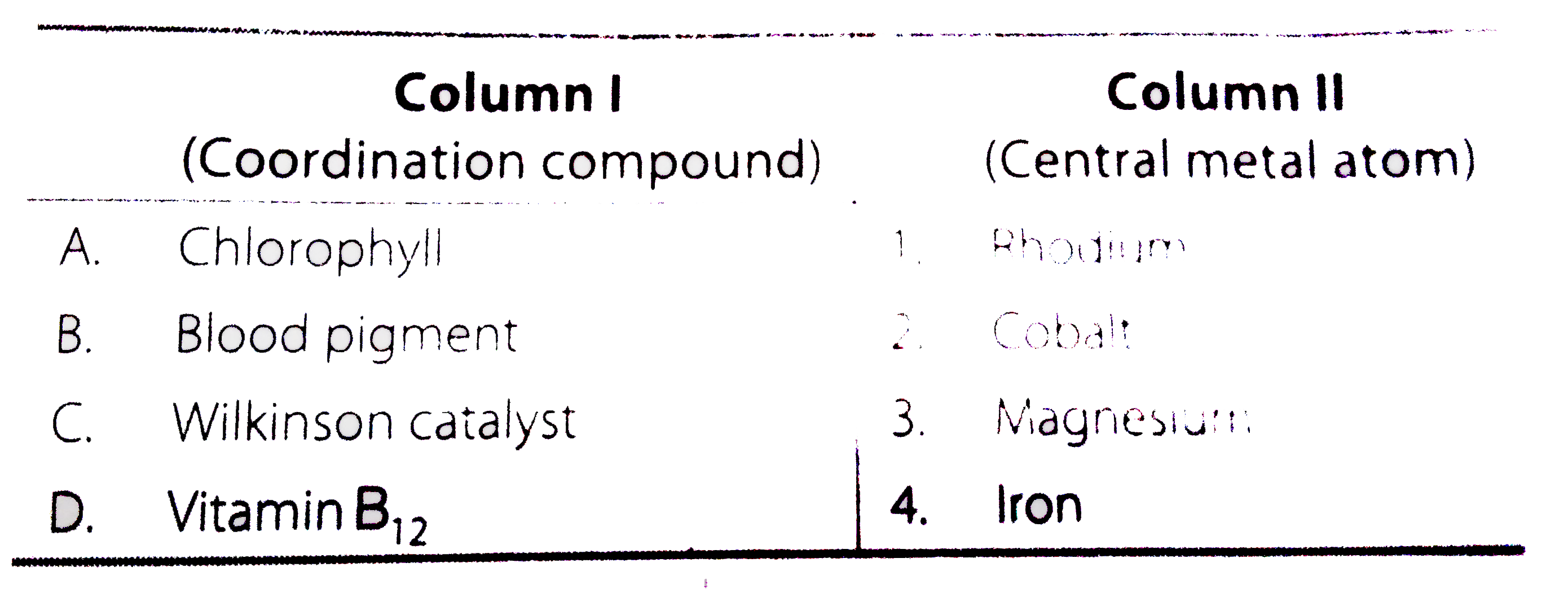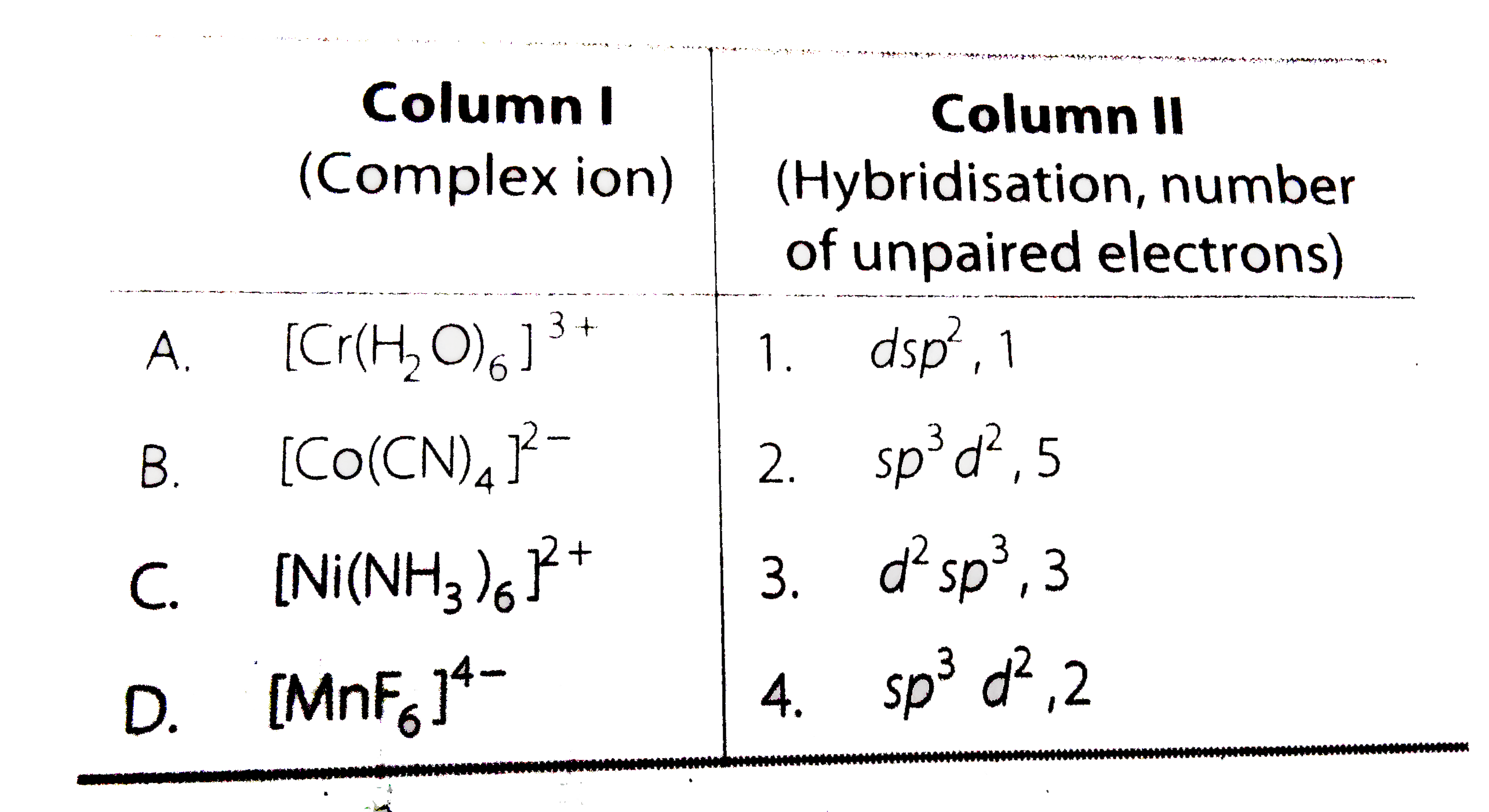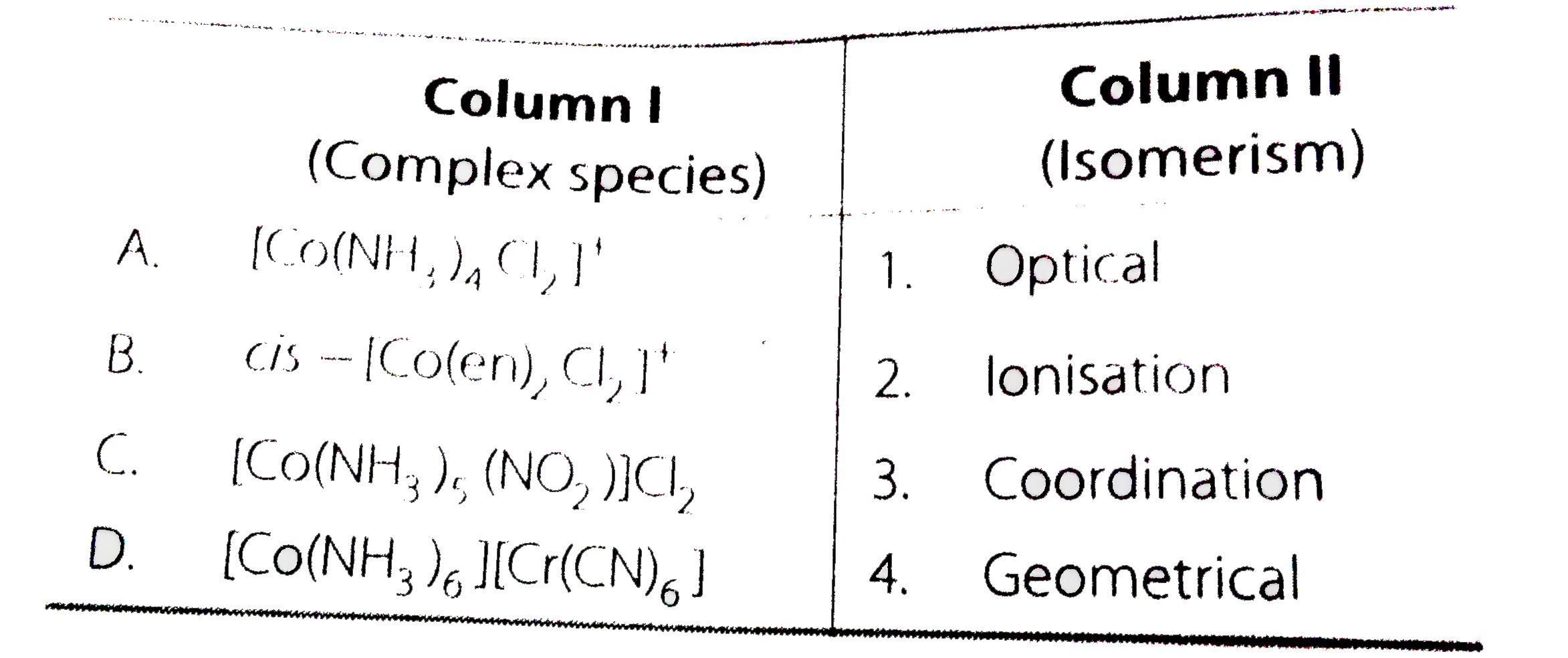Complete Solutions to Coordination Compounds of chapter COORDINATION COMPOUNDS of Class 12 book with complete answers and questions
| Class 12 | CHEMISTRY |
| Chapter | COORDINATION COMPOUNDS |
| NCERT EXEMPLAR | Coordination Compounds |
| Number Of Questions | 50 |
| Academic Year | 2023-24 |
Which of the following complexes formed by `Cu^(2+)` ions is most stable ?
View SolutionThe colour of the coordination compounds depends on the crystal field splitting . What will be the correct order of obsorption of wavelength of light in the visible region, for the comolexes, `[Co(NH_(3))_(6)]^(3+)`m and `[Co(H_(2)O)_(6)^(3+)`?
View SolutionWhen 0.1 mol `CoCl_(3)(NH_(3))_(5)` is treated with excess of `AgNO_(3)`, 0.2 mole of AgCl are obtained. The conductivity of solution will correspond to
View SolutionWhen 1 mol `CrCl_(3).6H_(2)O` is treated with excess of `AgNO_(3)`, 3 mol of `AgCl` are obtained. The formula of the coplex is
View SolutionThe correct IUPAC name of `[Pt(NH_(3))_(2)Cl_(2)]` is
View SolutionThe stabilization of coordination compound due to chelation is called the chelate effect. Which of the following is the most stable complex species?
View SolutionIndicate the complex ion which shows geometrical isomerism.
View SolutionThe CFSE for octahedral `[CoCl_(6)]^(4-)` is `18,000 cm^(-1)`. The CFSE for tetrahedral `[CoCl_(4)]^(2-)` will be
View SolutionDue to the presence of ambidenate ligands coordination compounds show isomerism. Palladium complexes of the type `[Pd(C_(6)H_(5))_(2)(SCN)_(2)]` & `[Pd(C_(6)H_(5))_(2)(NCS)_(2)]` are
View SolutionThe two compounds `[Co(SO_(4))(NH_(3))_(5)]Br` and `[Co(SO_(4))(NH_(3))_(5)]Cl` represent:
View SolutionWhich of the following is not chelating agent
(a) Thiosulphate
(b) Oxalato
(c ) Glycinato
(d) Ethylene diamine .
View SolutionWhich of the following species is not expected to be a ligand?
View SolutionWhat kind of isomerism exists between `[Cr(H_(2)O)_(6)]Cl_(3)` (violet) and `[Cr(H_(2)O)_(5)Cl].H_(2)O` (greyish-green)?
View SolutionIUPAC name of `[Pt(NH_(3))_(2)Cl(NO_(2))]` is
View SolutionAtomic number of Mn. Fe and Co are 25, 26 and 27 respectively. Which of the following inner orbital octahedral complex ions are diamagnetic ?
View SolutionAtomic number of `Mn, Fe, Co` and `Ni` are 25, 26, 27 and 28 respectively. Which of the following outer orbital octahedral complexes have same number of unpaired electrons ?
View SolutionWhich of the following options are correct for `[Fe(CN)_(6)]^(3-)` complex ?
View SolutionAn aqueous pink solution of cobalt (II) chloride changes to deep blue on addition of excess of `HCl`. This is because ....... .
View SolutionWhich of the following complexes are homoleptic ?
View SolutionWhich of the following complexes are heteroleptic ?
View SolutionIdentify the optically active compounds from the following
View SolutionIdentify the correct statements for the behaviour of ethane-1, 2-diamine as a ligand.
View SolutionWhich of the following complexes show linkage isomerism ?
View SolutionArrange the following complexes in the increasing order of conductivity of their solution
`[Co(NH_(3))_(3)Cl_(3)], [Co(NH_(3))_(4)Cl_(2)]Cl, [Co(NH_(3))_(6)]Cl_(3), [Cr(NH_(3))_(5)Cl] Cl_(2)`
View SolutionA coordination compound `CrCI_(3).4H_(2)O` precipitates `AgCI` when treated with `AgNO_(3)` The molar conductance of its solution corresponds to a total of two ions Write the structural formula of the compound and name it .
View SolutionA complex of the type `[M(A A)_(2)X_(2)]` is known to the optically active. What does this indicate about the structure of the complex? Give one example of such complex .
View SolutionMagnetic moment of `[MnCl_(4)]^(2-)` is 5.92 BM. Explain giving reason present.
View SolutionOn the basis of crystal field theory explain why Co(III) Forms paramagnetic octahedral complex with weak field ligands whereas it forms diamagnetic octahedral complex with strong field ligands.
View SolutionWhy are low spin tetrahedral complexes not formed ?
View SolutionGive the electronic configuration of the following complexes on the basis of crystal field splitting theory. `[CoF_(6)]^(3-), [Fe(CN)_(6)]^(4-)` and `[Cu(NH_(3))_(6)]^(2+)`.
View SolutionExplain why `[Fe(H_(2)O)_(6)]^(3+)` has magnetic moment value of 5.92 BM where as `[Fe(CN)_(6)]^(3-)` has a value of only 1.74 BM ?
View SolutionArrange following complex ions in increasing order of crystal field splitting energy `(Delta_(0))`.
View SolutionWhy do compounds having similar geometry have different magnetic moment ?
View Solution`CuSO_(4).5H_(2)O` is blue in colour while `CuSO_(4)` is colourless. Why ?
View SolutionName the type of isomerism when ambidentate ligands are attched to central metal ion. Give two examples of ambidentate ligands.
View SolutionMatch the complex ions given in column I with the colours given in column II and assign the correct code.

View SolutionMatch the coordination compounds given in column I with the central metal atoms given in column II and assign the correct code.

View SolutionMatch the complex ions given in column I with the hybridisation and number of unpaired electrons given in column II and assign the correct code

View SolutionMatch the complex species given in column I with the possible isomerism given in Column II and assign the correct code.

View SolutionMatch the compounds given In column I with oxidation state of cabalt present in it (given in column II) and assign the correct code.

View SolutionAssertion (A) Toxic metal ions are removed by the chelating ligands.
Reason (R) Chelate complexes tend to be more stable.
View SolutionAssertion (A) `[Cr(H_(2)O_(6))]Cl_(2)` and `[Fe(H_(2)O)_(6)]Cl_(2)` are reducing in nature.
Reason (R) Unpaired electrons are present in their d-orbitals.
View SolutionAssertion (A) Linkage isomerism arises in coordination compounds containing ambidnetate ligand.
Reason (R) Ambidentate ligand has two different donor atoms.
View SolutionAssertion (A) Complexes of `MX_(6)` and `MX_(5)L` type (X and L are unidentate) do not show geometrical isomerism.
Reason (R) Geometrical isomerism is not shown by complexes of coordination number 6.
View SolutionAssertion (A) `[Fe(CN)_(6)]^(3-)` ion shows magnetic moment corresponding to two unpaired electrons.
Reason (R) Because it has `d^(2)sp^(3)` type hybridisation.
View SolutionUsing crystal field theory, draw energy level diagram, write electronic configuration of the central metal atom/ion and determine the magnetic moment value in the following
(a) `[CoF_(6)]^(3-), [Co(H_(2)O)_(6)]^(2+), [Co(CN)_(6)]^(3-)`
(b) `FeF_(6)^(3-), [Fe(H_(2)O)_(6)]^(2+), [Fe(CN)_(6)]^(4-)`
View SolutionUsing valence bond theory, explain the following in relation to the complexes given below
`[Mn(CN)_(6)]^(3-), [Co(NH_(3))_(6)]^(3+), [Cr(H_(2)O)_(6)]^(3+), [FeCl_(6)]^(4-)`
(a) type of hybridisation
(b) Inner or outer orbital complex
(c) Magnetic behaviour
(d) Spin only magnetic moment value.
View Solution`CoSO_(4)Cl.5 NH_(3)` exists in two isomeric forms 'A' and 'B'. Isomer 'A' reacts with `AgNO_(3)` to give white precipitate, but does not react with `BaCl_(2)`. Isomer 'B' gives white precipitate with `BaCl_(2)` but does not react with `AgNO_(3)`. Answer the following questions.
(a) Identify 'A' and 'B' and write their structural formulae.
(b) Name the type of isomerism involved.
(c) Give the IUPAC name of 'A' and 'B'.
View Solutionwhat is the relationsphip between observed colour of the complex and the wavelength of light absorbed by the complex ?
View SolutionWhy are different colours observed in octahedral and tetrahedral complexes for the same metal and same ligands ?
View Solution
Coordination Compounds questions and complete solutions for chapter COORDINATION COMPOUNDS of CHEMISTRY of Class 12